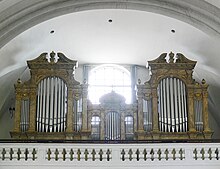St. Martin (Bamberg)
The Martinskirche in Bamberg is a Catholic parish church consecrated to St. Martin in the center of the city.
history
From 1248, the monastery in the Au of the Carmelite Order with its monastery church was located on the area of the Jesuit college with the St. Martin's Church . In 1589 this place was given to the seminary of the diocese of Bamberg in exchange . The Carmelite Order moved into the former Cistercian convent of St. Maria et Theodor on the Lower Kaulberg, which had been vacant since 1548 . This monastery still exists.
After the Jesuits were called and moved in in 1611, they took over the former Carmelite monastery. After acquiring several properties on the market, the east-facing church of the former Carmelite monastery was demolished and in 1686 construction of a new church began. The choir of the current church is west and is located approximately at the location of the choir of the east-facing Carmelite Church. The builders were the brothers Georg and Leonhard Dientzenhofer . Georg Dientzenhofer was brought from Prague for this. After Georg's death, his brother Leonhard took over the construction management.
The huge building was completed within seven years. With him the Dientzenhofer era of the Franconian Baroque began . B. the New Residence , the monasteries Banz , Ebrach and Michelsberg , Pommersfelden Castle and many other buildings. In 1693 the church was consecrated in the name of Jesus. With the completion of the church tower in 1696, the foundation stone for the Jesuit college was laid.
After secularization in 1804, the Jesuit Church became a parish church, was given the patronage of the demolished St. Martin Church , which stood on Maxplatz, and has been the parish church of the lower town ever since.
Due to structural damage that occurred, the church was temporarily closed in 2012 and renovated from autumn 2013. The official reopening took place on November 6, 2016 by Archbishop Ludwig Schick .
architecture
The east facade of the Martinskirche is two-storey with a risalit gable and the facade figures Jesus, Sebastian, Maria and Laurentius and is modeled on the mother church of the Jesuits Il Gesù in Rome. This becomes clear in the following pictures.
The position of the tower in the apex of the choir is also a characteristic feature of Jesuit church architecture.
The inner
The side chapels of the chancel are decorated with paintings by Oswald Onghers showing the religious saints Ignatius von Loyola and Franz Xavier . Particularly worth seeing is the false dome by Giovanni Francesco Marchini, designed by Andrea Pozzo, above the vestibule of the choir.
At the Marien Altar to the right of the choir is a Pietà , which comes from the Liebfrauenkapelle in Widdern and came to Bamberg in 1617. The statue was already a destination for pilgrimages in Widdern and was venerated from 1625 in the predecessor building of today's Martinskirche, the old St. Martins Church .
crypt
At the pulpit staircase on the left is the access to the crypt , in which Jesuit fathers are buried in sliding graves . Under the crypt there is an inaccessible room, closed off by a sandstone cover; the bones from the graves, which had to be emptied, were buried there.
Bells
In the 55 m high bell tower, completed in 1696, there is a historical bell, consisting of the five ringable bells with the striking tone sequence h 0 –c 1 –e 1 –gis 1 –h 1 , which form the plenum, as well as a bell that can no longer be rung, the is in the tower lantern.
organ
The organ was built in 1894 by GF Steinmeyer (Oettingen) with 38 registers on mechanical cone chests (with Barker machines). In 1934, the organ building company replaced the action with electropneumatic ones and added a swell mechanism to the instrument . The disposition was slightly redesigned in line with the organ movement. In 1938 the instrument was expanded again by the organ building company Hindelang, Ebenhofen.
Between 1999 and 2000 the instrument was extensively restored by the organ building company Hermann Eule (Bautzen) and returned to its condition from 1894. The historical pipe material is largely available. Only six registers had to be reconstructed. The cone chests are played mechanically. The sound contractures are supported by reconstructed Barker machines. The free-standing console based on the Steinmeyer model and the organ front were also reconstructed. The instrument is now equipped with an electronic setting system.
|
|
|
||||||||||||||||||||||||||||||||||||||||||||||||||||||||||||||||||||||||||||||||||||||||||||||||||||||||||||||||||||||||||||||
- Coupling : II / I, I / P, II / P
- Playing aids : 5 collective kicks as fixed combinations, electronic setting system
- E = (partially) reconstructed register (2000)
Clergy at this church
- Nikolaus Haas , pastor, historian, author of articles on the history of Bamberg and the surrounding area
- Lorenz Hopfenmüller was given the fourth chaplaincy on October 1, 1867. He became known as a culture fighter and missionary to India.
literature
- Bruno Neundörfer: St. Martin in Bamberg . Schnell, Art Guide No. 72, Verlag Schnell & Steiner Munich and Zurich ISBN 978-3-7954-4124-1
Web links
- The St. Martin Church in Bamberg ( Memento from September 27, 2007 in the Internet Archive )
- Homepage of the parish of St. Martin
- Full ringing of the bells on YouTube
Individual evidence
- ↑ St. Martin in Bamberg receives support from the German Foundation for Monument Protection , accessed on August 7, 2017.
- ↑ Homepage of the parish of St. Martin: Bells , accessed on August 7, 2017.
- ↑ Homepage of the parish of St. Martin: fire bell , accessed on August 7, 2017.
- ↑ In detail on the history and reconstruction of the Steinmeyer organ ( memento from October 19, 2011 in the Internet Archive )
Coordinates: 49 ° 53 ′ 37 ″ N , 10 ° 53 ′ 18 ″ E









